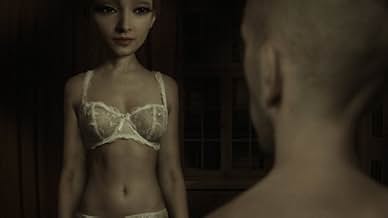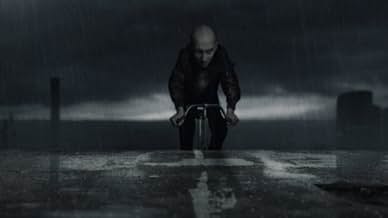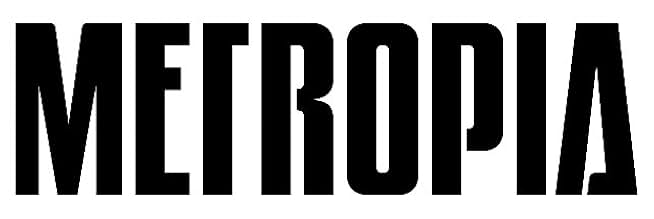NOTE IMDb
6,2/10
8,3 k
MA NOTE
Ajouter une intrigue dans votre langueA complex story of a misaligned man, though good intent, creating a nightmarish Dystopian existence.A complex story of a misaligned man, though good intent, creating a nightmarish Dystopian existence.A complex story of a misaligned man, though good intent, creating a nightmarish Dystopian existence.
- Réalisation
- Scénario
- Casting principal
- Récompenses
- 3 victoires et 6 nominations au total
Juliette Lewis
- Nina
- (voix)
Sofia Helin
- Anna Svensson
- (voix)
Shanti Roney
- Karl
- (voix)
Fares Fares
- Firaz
- (voix)
Fredrik Eddari
- Mehmet
- (voix)
Joanna Mikolajczyk Winterø
- The Metro
- (voix)
- (as Joanna Zofia Bard Mikolajczyk)
Magnus Skogsberg
- Roger's Boss
- (voix)
- (as Magnus Skogsberg Tear)
Lotta Bromé
- News Anchor
- (voix)
Avis à la une
One gets accustomed to certain styles of animation, not to mention certain themes. It's either for kids or adults, and it's either 2D or 3D. Of course there are exceptions but for the sake of simplicity, this Manichean duality dominates the market. It's rare that a film emerges that challenges these notions but Tarik Saleh's Metropia does that in fairly interesting ways. The style is an bit of a mash-up between 2 and 3 D - the frames are digitally composited from head shots that have been stretched and squashed then placed on smallish bodies creating creepy caricatures of the actors being photographed. The effect, visually, is of the puppetry in a Thunderbirds (or Supercar) episode as designed by Drew Friedman, with a heavy dose of dark Gilliam"esquire." despair. The animation is stiff, stylized and intentionally rough and jerky. Metropia is not super deep at it core, but it reminds me of the Heavy Metal comics I used to devour when I was a teenager, and that's not at all bad.
It's 2024, the world is running out of oil, and Europe has been connected via a huge subway system. The skies are always gray and it rains all the time. Roger, our protagonist, a bald, hydrocephalic, stoop-shouldered everyman, is afraid to take the metro because he has been hearing voices. He lives with his girlfriend who seems to always be on another planet. One morning, Roger is forced to take the metro because his bike (which he was using illegally anyway) has been destroyed. Sure enough, he begins to hear voices, a voice that has been seeping into his life away from the Metro, on top of everything. On that fateful subway ride, he sees Nina, the spitting image of the girl on his shampoo bottle - a shampoo called Dangst, if that gives any clue as to the relative depth of the film in question. On impulse - despite the urging of the voice in his head - Roger follows Nina, and discovers the world, not far beneath the surface, is not quite what it seems.
As I mentioned, the concepts are pretty thin. The requisite global corporate conspiracy, the rampant consumerism in a dysfunctional dystopia, and the soul-dead protagonist in a souls dead world, are requisite tropes for a film like this. Of course, They have been executed more competently, and in more depth, elsewhere, but the strength of Metropia is its visuals. It is animated for a reason. To that end, the spare, creepy animation style suits the film perfectly. By now, whiz-bang 3D animations are the norm, the rule, so it's at first disconcerting to see animation used so sparingly, minimally and strangely. But this is the point. The world has had all the life and energy sucked out of it, it's no wonder there's not much energy left for the inhabitants of said world. The familiar grey palette allows for even the most subdued tan coat and blonde hair of Nina's to stand out. This lack of movement is also a symbol of conformity. Literally, don't stand out.
Despite its familiar themes, Metropia is worth screening for the simple marriage of form and function it represents. It's a brave filmmaker, who, in this age of Avatar, chooses to make a quiet, simple, creepy film. Saleh, gives us a film, not breathtaking in it's scope, or necessarily ground breaking (except for what it doesn't strive to achieve: mindless spectacle) but calm, understated and worthy, for serious fans of animation, and the brand of sci if familiar to fans of Heavy Metal (the magazine, not the movie).
It's 2024, the world is running out of oil, and Europe has been connected via a huge subway system. The skies are always gray and it rains all the time. Roger, our protagonist, a bald, hydrocephalic, stoop-shouldered everyman, is afraid to take the metro because he has been hearing voices. He lives with his girlfriend who seems to always be on another planet. One morning, Roger is forced to take the metro because his bike (which he was using illegally anyway) has been destroyed. Sure enough, he begins to hear voices, a voice that has been seeping into his life away from the Metro, on top of everything. On that fateful subway ride, he sees Nina, the spitting image of the girl on his shampoo bottle - a shampoo called Dangst, if that gives any clue as to the relative depth of the film in question. On impulse - despite the urging of the voice in his head - Roger follows Nina, and discovers the world, not far beneath the surface, is not quite what it seems.
As I mentioned, the concepts are pretty thin. The requisite global corporate conspiracy, the rampant consumerism in a dysfunctional dystopia, and the soul-dead protagonist in a souls dead world, are requisite tropes for a film like this. Of course, They have been executed more competently, and in more depth, elsewhere, but the strength of Metropia is its visuals. It is animated for a reason. To that end, the spare, creepy animation style suits the film perfectly. By now, whiz-bang 3D animations are the norm, the rule, so it's at first disconcerting to see animation used so sparingly, minimally and strangely. But this is the point. The world has had all the life and energy sucked out of it, it's no wonder there's not much energy left for the inhabitants of said world. The familiar grey palette allows for even the most subdued tan coat and blonde hair of Nina's to stand out. This lack of movement is also a symbol of conformity. Literally, don't stand out.
Despite its familiar themes, Metropia is worth screening for the simple marriage of form and function it represents. It's a brave filmmaker, who, in this age of Avatar, chooses to make a quiet, simple, creepy film. Saleh, gives us a film, not breathtaking in it's scope, or necessarily ground breaking (except for what it doesn't strive to achieve: mindless spectacle) but calm, understated and worthy, for serious fans of animation, and the brand of sci if familiar to fans of Heavy Metal (the magazine, not the movie).
So first of all: In general I am a big fan of low-budget and small films. I think thats where the real passion is.
And Metroia really was a one-man-thing. At least that what I took from it. So there is a pretty impressive achievement here. No doubt. I respect that. I like that.
So it kinda hurts me that I have to say that Metropia would have been a better short film then a feature. It sometimes just dragged. And not in a moody or artistic way (dont worry, I am all in for Tarkovsky and Co) but just with spans of scenes that are not interesting. You can argue that a certain kind of monotony helps you understand the character better. I guess thats correct. But there was still a little underwhelming taste in the end.
And Metroia really was a one-man-thing. At least that what I took from it. So there is a pretty impressive achievement here. No doubt. I respect that. I like that.
So it kinda hurts me that I have to say that Metropia would have been a better short film then a feature. It sometimes just dragged. And not in a moody or artistic way (dont worry, I am all in for Tarkovsky and Co) but just with spans of scenes that are not interesting. You can argue that a certain kind of monotony helps you understand the character better. I guess thats correct. But there was still a little underwhelming taste in the end.
A very unique Scandinavian-English language film from the technical aspect. The only one kind in the whole world which is actually an experimental product from the new productions. It was made primarily using photoshop, and then adobe after effects for animation. If you're wondering what kind it is, actually a 2.5D animation, that means it is neither 2D or 3D, but between those two. Like tricking the 2D object as the 3D material.
Well they have succeeded to bring a visually impressive animation that mainly focused on the film character faces. The story was decent which is another dystopian concept where metro trains are the main content, hence it is called 'Metropia'. But the title also means 'visual refraction', that's what the story is slightly related too.
Anyway, it was very suspenseful till the final and mostly talking drama than physical action sequences. At some point I felt it was like the recent stop-motion animation 'Anomalisa', but realised that I predicted wrong and the story travelled in a different path to end decently. Though the overall film was very impressive from both technical and narrative wise. One must not miss it, just for a its rare kind, especially you like animations, but best suitable for adults.
7/10
Well they have succeeded to bring a visually impressive animation that mainly focused on the film character faces. The story was decent which is another dystopian concept where metro trains are the main content, hence it is called 'Metropia'. But the title also means 'visual refraction', that's what the story is slightly related too.
Anyway, it was very suspenseful till the final and mostly talking drama than physical action sequences. At some point I felt it was like the recent stop-motion animation 'Anomalisa', but realised that I predicted wrong and the story travelled in a different path to end decently. Though the overall film was very impressive from both technical and narrative wise. One must not miss it, just for a its rare kind, especially you like animations, but best suitable for adults.
7/10
I just screened this in advance of its showing at the San Francisco International Animation Festival. It's an interesting film, more for its technique than its narrative. Set in the not-to-distant future in a VERY bleak world, it tells the story of one man's fight against an evil corporation's machinations. Nothing really new narrative-wise, but the plot really isn't the point of this film. It's the animation. The process uses photomontage as its basis, and is quite creepy in its execution. The voice work is well done, and it's always good to see/hear cult film fave Udo Kier. If you enjoyed "1984" or "Brazil," you might want to check this film out.
Take a trip to Europe in the year 2024. This is a dark age, where the automobile is no longer in use, replaced by a cross country subway system. The most popular product on the market (in fact pretty much the only item) is a shampoo manufactured with a secret mind controlling chemical, which the major corporations use to monitor the public in George Orwell fashion.
In an age where animation can do anything, the decision to do almost nothing certainly stands out in film. Metropia is without doubt the bleakest animated feature I know; a murky institutional world, without a drop of color or sunshine, and everywhere we go is under lit. This makes enough sense when taking into account that this is a future where society is low on energy.
Not everything however feels credible. The absence of people in great numbers is unusual. The few people who do wander in and out of frame are almost hollow shells. They have no soul, but more importantly they have no movement. Metropia uses the least amount of energy possible to give life to illustrations. To attempt to describe it is not impossible, but it's something that is better off seen for ones self. Metropia is a haunting experience. It's almost a ghost world, not just from the absence of sight, but from the absence of sound. Metropia makes effective use of silence in all the right places, accompanied by an effective, very new age score.
As for the storyline, it is familiar, but not painfully so. It's similar to Brazil, which itself is the product of George Orwell's influence. The climax here feels a bit rushed, and easy, leaving Metropia a bit shorter than I think it should've been, but it remains an entertaining experiment.
In an age where animation can do anything, the decision to do almost nothing certainly stands out in film. Metropia is without doubt the bleakest animated feature I know; a murky institutional world, without a drop of color or sunshine, and everywhere we go is under lit. This makes enough sense when taking into account that this is a future where society is low on energy.
Not everything however feels credible. The absence of people in great numbers is unusual. The few people who do wander in and out of frame are almost hollow shells. They have no soul, but more importantly they have no movement. Metropia uses the least amount of energy possible to give life to illustrations. To attempt to describe it is not impossible, but it's something that is better off seen for ones self. Metropia is a haunting experience. It's almost a ghost world, not just from the absence of sight, but from the absence of sound. Metropia makes effective use of silence in all the right places, accompanied by an effective, very new age score.
As for the storyline, it is familiar, but not painfully so. It's similar to Brazil, which itself is the product of George Orwell's influence. The climax here feels a bit rushed, and easy, leaving Metropia a bit shorter than I think it should've been, but it remains an entertaining experiment.
Le saviez-vous
- AnecdotesAnna wears a T-shirt that says "Maybe he hasn't called because he's washing his hair".
- GaffesWhen Anna is doodling on the mail, it is clearly seen that the debt collection agency has spelled its business as "dept collection".
- ConnexionsReferenced in Stockholms 20th International Film Festival (2009)
Meilleurs choix
Connectez-vous pour évaluer et suivre la liste de favoris afin de recevoir des recommandations personnalisées
- How long is Metropia?Alimenté par Alexa
Détails
Box-office
- Budget
- 32 000 000 SEK (estimé)
- Montant brut mondial
- 81 305 $US
- Durée
- 1 heure et 26 minutes
- Couleur
- Mixage
- Rapport de forme
- 1.85 : 1
Contribuer à cette page
Suggérer une modification ou ajouter du contenu manquant






























